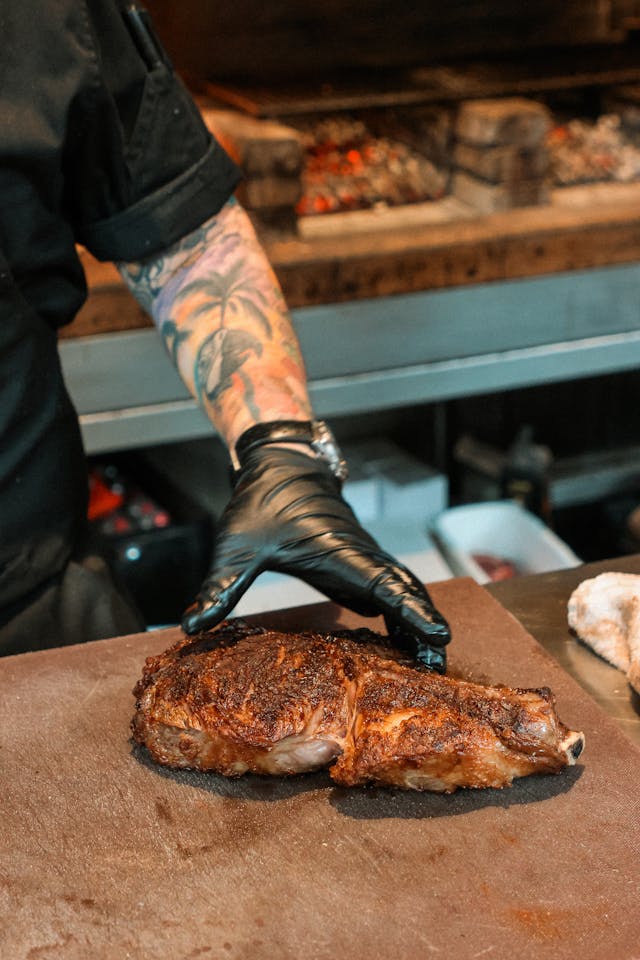Ribeye steak, a staple of premium dining, begins its story in the primal cuts of a cow’s anatomy. Derived from the rib section, typically ribs six through twelve, the ribeye is celebrated for its marbling, tenderness, and rich flavor. But this prized cut does not happen by chance. It is the culmination of skilled butchery and careful selection of meat, each step crucial in preserving the quality that diners expect.

Expert butchers meticulously separate the ribeye from the rib primal, ensuring a uniform cut that maintains its iconic texture and fat distribution. This fat—often referred to as marbling—is the key to the ribeye’s renowned juiciness and flavor. Unlike leaner cuts, the ribeye’s intramuscular fat renders beautifully when cooked, infusing the meat with an unmatched depth of taste.
The journey doesn’t end with the butcher. The storage and aging process are equally important. Dry-aging, a method that enhances flavor and tenderness by allowing natural enzymes to break down the muscle fibers, is particularly popular for ribeye steaks. This process requires precision and time, often taking several weeks, to develop the characteristic nutty and robust flavor that steak enthusiasts adore.
Why Ribeye Stands Out: Flavor and Texture
What sets the ribeye apart from other cuts is its unique balance of flavor and texture. The marbling—tiny streaks of fat woven through the muscle—ensures a buttery tenderness that melts in your mouth. This natural fat also acts as a conductor for flavor, making each bite a luxurious experience for the palate.
The ribeye’s flavor profile is unparalleled, combining a beefy richness with a subtle sweetness brought out by its fat content. The cap of the ribeye, known as the spinalis dorsi, is particularly revered for its juicy texture and intense flavor. This part of the steak often has a slightly firmer bite compared to the central eye, offering a delightful contrast.
Moreover, the ribeye’s adaptability in cooking methods makes it a favorite among chefs and home cooks alike. Whether it’s seared on a cast-iron skillet, grilled to smoky perfection, or broiled under high heat, the ribeye consistently delivers exceptional results. This versatility, combined with its robust flavor and tender texture, solidifies its status as a top-tier steak.
Choosing the Perfect Ribeye: What to Look For
Selecting the perfect ribeye steak requires an eye for quality and a basic understanding of beef grading. The USDA grades beef in three primary categories: Prime, Choice, and Select. Prime-grade ribeye, often sourced from well-marbled cattle, is the pinnacle of quality, offering superior tenderness and flavor.
When purchasing a ribeye, marbling should be the first consideration. Look for fine, evenly distributed fat throughout the muscle. Avoid cuts with large chunks of exterior fat, as these can detract from the eating experience. Thickness is another important factor; a steak at least one inch thick is ideal for achieving the perfect sear while maintaining a juicy interior.
For those seeking an unparalleled dining experience, consider exploring premium options such as Wagyu beef. Brands like destinationwagyu.com offer expertly-crafted ribeye steaks with exceptional marbling and a melt-in-your-mouth texture. These premium cuts provide a dining experience that rivals that of high-end steakhouses, delivered conveniently to your door.
Preparing Ribeye for Cooking: Techniques and Tips
Preparation is key to maximizing the potential of a ribeye steak. Before cooking, it is essential to bring the steak to room temperature. Allowing the meat to rest outside the refrigerator for 30 to 60 minutes ensures even cooking, preventing the exterior from overcooking while the center remains cold.
Seasoning should be simple yet effective. Coarse salt and freshly cracked black pepper are all that’s needed to enhance the ribeye’s natural flavors. For an added layer of flavor, some cooks prefer to use a garlic herb butter or a dry rub featuring paprika, garlic powder, and cayenne.
When it comes to cooking, high heat is your best ally. Searing the steak at a high temperature creates a Maillard reaction, the chemical process responsible for the steak’s golden-brown crust. This crust not only adds a delightful texture but also intensifies the meat’s savory flavor. A reverse-sear method, where the steak is first cooked slowly in the oven and then finished with a high-temperature sear, is another popular technique that guarantees a perfect crust and tender interior.
Cooking Methods: Sear, Grill, or Broil?
The ribeye steak’s versatility allows it to shine across various cooking methods. Each technique offers its unique advantages and contributes to the steak’s distinct flavor and texture.
Searing is ideal for those who enjoy a crusty exterior and a juicy, medium-rare interior. A cast-iron skillet heated to high temperature is perfect for achieving this result. By using a combination of butter, garlic, and fresh herbs during the cooking process, you can enhance the steak’s natural flavors further.
Grilling adds a smoky dimension that complements the ribeye’s beefy richness. Charcoal grills, in particular, impart a depth of flavor that’s difficult to replicate with other methods. To prevent flare-ups from the melting fat, it’s advisable to use a two-zone grilling method: direct heat for searing and indirect heat for finishing.
Broiling offers a convenient and efficient way to cook ribeye, especially in colder months when outdoor grilling isn’t feasible. Positioning the steak a few inches from the broiler element ensures a beautifully caramelized crust while locking in the juices. Rotating the steak halfway through the cooking process guarantees even results.
Savoring the Ribeye: Pairings and Presentation
A ribeye steak deserves thoughtful pairings and elegant presentation to complete the dining experience. Side dishes such as creamy mashed potatoes, roasted asparagus, or a fresh arugula salad provide balance and enhance the steak’s richness. For a bolder pairing, consider truffle mac and cheese or caramelized Brussels sprouts.
Wine pairings also elevate the ribeye experience. Full-bodied red wines such as Cabernet Sauvignon or Malbec complement the steak’s robust flavor and fat content. For those who prefer white wine, a buttery Chardonnay can offer a surprisingly delightful pairing.
Presentation matters too. Allow the steak to rest for five to ten minutes after cooking, ensuring the juices redistribute evenly. Slice against the grain for optimal tenderness and arrange on a warmed plate. A garnish of fresh rosemary or a drizzle of balsamic glaze adds a finishing touch that’s both visually appealing and flavorful.
The Ribeye’s Role in Culinary Culture
The ribeye steak holds a special place in culinary culture, embodying indulgence and excellence. Its storied history—from being a butcher’s secret to becoming a menu highlight in world-class steakhouses—reflects its universal appeal. The ribeye’s reputation has grown alongside the evolving tastes of steak lovers, who increasingly value quality and craftsmanship.
As food culture emphasizes sustainability and ethical sourcing, the ribeye has become a symbol of mindful consumption. High-quality producers focus on humane practices and premium feed, ensuring a superior product that aligns with consumer values. This shift has elevated the ribeye from a mere cut of meat to a culinary icon.
Whether enjoyed at a backyard barbecue or a Michelin-starred restaurant, the ribeye steak continues to captivate. Its unmatched combination of flavor, tenderness, and versatility ensures it remains a favorite, celebrating the timeless art of steak preparation and enjoyment.
















Add Your Comment